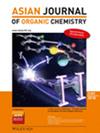A Serendipitous Non‐Metal‐Mediated Sp3 C─H Functionalization of 2‐Methyl Indolyl Scaffold for the Synthesis of 2‐Alkenyl Indoles*
IF 2.7
4区 化学
Q1 CHEMISTRY, ORGANIC
引用次数: 0
Abstract
Challenging conventional methodologies, we pioneer a groundbreaking approach by C─H functionalization of sp3 carbon, which leads to the effective synthesis of 2‐alkenyl indole scaffold, bioactive olefin. Our study introduces an innovative approach by utilizing previously unexplored starting materials, expanding the possibilities of C─H functionalization. In contrast to previous studies that rely on metal‐based catalysts, our strategy harnesses a cost‐effective and environmentally friendly method. This functionalization was effectively promoted by NH4Cl and MgSO4, ensuring high efficiency, exceptional selectivity, and excellent yields under mild conditions. A series of spectroscopic techniques, including NMR (¹H, ¹3C, 19F, and DEPT‐135), IR, and mass spectrometry, were used for the detailed characterization of the synthesized 2‐alkenyl indoles. This method not only demonstrates broad functional group compatibility but also establishes a sustainable alternative to traditional metal‐catalyzed processes. By redefining the scope of this reaction, our work paves the way for future advancements in organic synthesis and biomedical applications.

非金属介导的Sp3 C─H功能化2-甲基吲哚基支架合成2-烯基吲哚*
挑战传统的方法,我们开创了一种开创性的方法,通过sp3碳的C─H功能化,可以有效地合成2-烯基吲哚支架,生物活性烯烃。我们的研究引入了一种创新的方法,利用以前未开发的起始材料,扩大了C─H功能化的可能性。与以往依赖金属基催化剂的研究相比,我们的策略采用了一种成本效益高、环境友好的方法。NH4Cl和MgSO4有效地促进了这种官能化反应,在温和的条件下保证了高效率、高选择性和高收率。采用NMR(¹H,¹3C, 19F, DEPT-135), IR和质谱等一系列光谱技术对合成的2-烯基吲哚进行了详细的表征。该方法不仅展示了广泛的官能团相容性,而且建立了传统金属催化工艺的可持续替代方案。通过重新定义这种反应的范围,我们的工作为有机合成和生物医学应用的未来发展铺平了道路。
本文章由计算机程序翻译,如有差异,请以英文原文为准。
求助全文
约1分钟内获得全文
求助全文
来源期刊

Asian Journal of Organic Chemistry
CHEMISTRY, ORGANIC-
CiteScore
4.70
自引率
3.70%
发文量
372
期刊介绍:
Organic chemistry is the fundamental science that stands at the heart of chemistry, biology, and materials science. Research in these areas is vigorous and truly international, with three major regions making almost equal contributions: America, Europe and Asia. Asia now has its own top international organic chemistry journal—the Asian Journal of Organic Chemistry (AsianJOC)
The AsianJOC is designed to be a top-ranked international research journal and publishes primary research as well as critical secondary information from authors across the world. The journal covers organic chemistry in its entirety. Authors and readers come from academia, the chemical industry, and government laboratories.
 求助内容:
求助内容: 应助结果提醒方式:
应助结果提醒方式:


